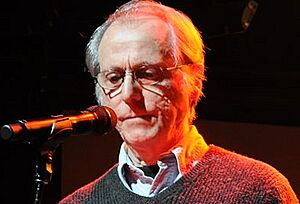Italian American facts for kids
| Italoamericani | |
|---|---|
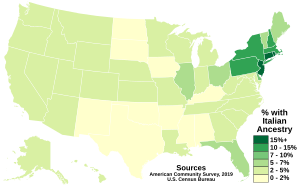
Americans with Italian ancestry by state according to the U.S. Census Bureau's American Community Survey in 2019
|
|
| Total population | |
| 17,767,630 (4.8%) alone or in combination 5,953,262 (1.8%) Italian alone |
|
| Regions with significant populations | |
| Northeastern United States (parts of New York, New Jersey, Pennsylvania, Delaware, Massachusetts, New Hampshire, Connecticut and Rhode Island); Illinois (especially Chicago); also, parts of Baltimore–Washington, Ohio, St. Louis, Kansas City, Milwaukee, Detroit; parts of California (such as Los Angeles, San Francisco and San Diego), Florida (particularly the southern part of the state) and the Atlantic coast, Louisiana (especially New Orleans), with growing populations in Denver, Las Vegas, Phoenix and Albuquerque |
|
| Languages | |
| Italian American pidgin (including Itanglese and Siculish) | |
| Religion | |
| Predominantly Catholicism with small minorities practicing Protestantism and Judaism | |
| Related ethnic groups | |
| Italian Argentines, Italian Brazilians, Italian Chileans, Italian Venezuelans, Italian Uruguayans, Italian Peruvians, Italian Canadians, Italian Mexicans, Italian Australians, Italian South Africans, Italian Britons, Italian New Zealanders, Sicilian Americans, Corsican Americans, Corsican-Puerto Ricans, Maltese Americans, and other Italians |

First row: Madonna, Fiorello La Guardia, Robert DeNiro
Second row: Francis Ford Coppola, Nancy Pelosi, Frank Sinatra
Third row: Joe DiMaggio, Samuel Alito, Rudy Giuliani
Fourth row: Martin Scorsese, Enrico Fermi, Chris Botti.
An Italian American is a U.S. citizen who has Italian family roots. This can mean someone born in the United States whose parents or grandparents came from Italy. It can also mean someone born in Italy who later moved to the United States.
Many Italians moved to the United States in the early 1900s. About two million arrived between 1900 and 1914. Only people from Ireland and Germany moved to the U.S. in larger numbers during that time. In 2000, the government counted about 15.6 million Italian Americans. This means that about 56 out of every 1000 Americans were Italian Americans.
Italian Americans have helped build the United States in many ways. Many important politicians, inventors, scientists, soldiers, musicians, and film makers have been Italian Americans. Most Italian immigrants came from southern Italy, especially from places like Sicily, Naples, and Calabria. Only a smaller number came from Northern Italy.
New York City has more Italian Americans than any other U.S. city. Over 3 million Italians live in or near New York. The states of New Jersey, Pennsylvania, California, Florida, and Massachusetts also have many Italian Americans. Large Italian American groups live in cities like Chicago, Boston, Philadelphia, Detroit, and Ohio. Each of these cities has over half a million people of Italian descent.
Contents
- History of Italian Immigration
- Economy and Business
- Science and Innovation
- Literature and Authors
- Education and Learning
- Italian American Pidgin Language
- Cuisine and Food
- Folklore and Celebrations
- Television and Media
- Museums and Culture Centers
- Discrimination and Stereotypes
- Demographics and Population
- U.S. States with Many Italian Americans
- U.S. Communities with Many Italian Americans
- See also
History of Italian Immigration
Between 1820 and 2004, about 5.5 million Italians moved from Italy to the United States. This happened in different waves. The largest number arrived in the 20th century, mostly from Southern Italy. At first, many Italian immigrants were single men. They would send money back to their families in Italy. Many of them eventually returned home. However, many others stayed in the United States. They created the large Italian American communities we see today.
Before the big wave of Italian immigrants, there were fewer than 25,000 Italians in America in 1870. Many of them were Northern Italian refugees. They were escaping wars that led to the unification of Italy in 1870.
Immigration grew a lot during the 1870s. More than twice as many Italians moved to the U.S. then compared to the five decades before. The biggest surge happened between 1880 and 1914. Over 4 million Italians came to the United States during this time. Most came from southern Italian regions like Abruzzo, Molise, Campania, Apulia, Basilicata, Calabria, and Sicily. These areas were mostly rural and farming regions. Many people there were poor because of centuries of foreign rule. They also faced heavy taxes after Italy became one country in 1861.
This period of large immigration stopped suddenly when World War I began in 1914. It never fully returned to that level. However, many Italians still managed to immigrate. New laws in the 1920s limited immigration. The Immigration Act of 1924 was made to reduce immigration from Italy and other Southern and Eastern European countries. It set limits on how many people could come from each country each year.
After Italy became a united country, the Kingdom of Italy encouraged people to move away. This helped ease economic problems in Southern Italy. After the American Civil War, the U.S. needed more workers. Over half a million people were killed or hurt in the war. So, workers were brought in from Italy and other places.
In the United States, most Italians started their new lives as manual laborers. They worked in eastern cities, mining camps, and farms. Italians mainly settled in the Northeastern U.S. and other industrial cities in the Midwest. These places had many working-class jobs. The children and grandchildren of Italian immigrants slowly improved their economic standing. By 1970, their economic level was similar to the national average. Italian American communities often have strong family ties. They are also closely connected to the Catholic Church, community groups, and political parties.
Economy and Business
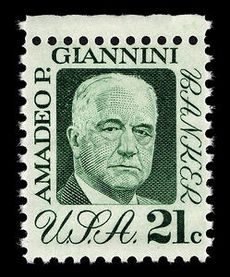
Italian Americans have played a big part in the U.S. economy. They have started very important companies. Some examples include Bank of America, founded by Amadeo Giannini in 1904. Other well-known companies include Qualcomm, Subway, Home Depot, and Airbnb. Italian Americans have also helped the U.S. economy grow with their business skills.
Many Italian Americans have been leaders (CEOs) of major companies. These include Lee Iacocca at Ford Motor Company and Chrysler Corporation. Samuel Palmisano led IBM Corporation. Patricia Russo was in charge of Lucent Technologies. Richard Grasso led The New York Stock Exchange. Michael Bonsignore was CEO of Honeywell Incorporated. Paul Otellini led Intel.
Economist Franco Modigliani won the Nobel Prize in Economics. He was recognized for his important work on saving money and financial markets. Another economist, Eugene Fama, won the Nobel Memorial Prize in Economic Sciences in 2013. He was honored for his studies on how investments work and how markets are efficient.
Science and Innovation
Italian Americans have made major discoveries in many science fields. These include engineering, medicine, and physics. Physicist and Nobel Prize winner Enrico Fermi created the world's first nuclear reactor. It was called the Chicago Pile-1. He was also a top scientist in the Manhattan Project during World War II. One of Fermi's helpers, Franco Rasetti, won an award for his work in paleontology.
Federico Faggin developed the first micro-chip and micro-processor. Robert Gallo led research that found a virus that can cause cancer. Anthony Fauci received the Presidential Medal of Freedom in 2008. This was for his work on the PEPFAR program, which helps people with AIDS.
Astrophysicist Riccardo Giacconi won the 2002 Nobel Prize in Physics. He helped discover sources of X-rays in space. Virologist Renato Dulbecco won the 1975 Nobel Prize in Physiology or Medicine for his work on viruses that cause tumors. Pharmacologist Louis Ignarro shared the 1998 Nobel Prize in Physiology or Medicine. He showed how nitric oxide helps the body send signals.
Microbiologist Salvador Luria won the Nobel Prize in Physiology or Medicine in 1969. He made important discoveries about how viruses copy themselves and their genetic makeup. Physicist William Daniel Phillips won the Nobel Prize in Physics in 1997. He was recognized for his work on laser cooling. Physicist Emilio Segrè discovered the elements technetium and astatine. He also found the antiproton, a tiny anti-particle. He won the Nobel Prize in Physics in 1959 for this.
Nine Italian Americans, including one woman, have become astronauts. They are Wally Schirra, Dominic Antonelli, Charles Camarda, Mike Massimino, Richard Mastracchio, Ronald Parise, Mario Runco, Albert Sacco, and Nicole Marie Passonno Stott. Rocco Petrone was the third director of the NASA Marshall Space Flight Center from 1973 to 1974.
Literature and Authors
Many early Italian American writers and poets published their works in the first half of the 20th century. These authors were often children of immigrants. Pietro Di Donato, born in 1911, was a writer famous for his novel, Christ in Concrete. Critics in the U.S. and other countries praised it. They saw it as a story about what it was like to be an immigrant in America.
Italian Americans have written about the Italian American experience. They have also written about the general human experience. Some very popular inspirational books have been written by Italian Americans. These include books by Og Mandino, Leo Buscaglia, and Antoinette Bosco. Tomie dePaola has written a series of inspiring books for children. Popular modern fiction writers include David Baldacci, Kate DiCamillo, Richard Russo, Adriana Trigiani, and Lisa Scottoline.
Education and Learning
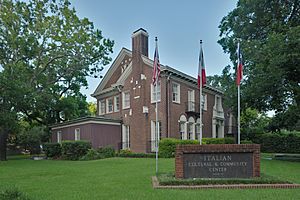
When many Italians first immigrated, families in rural Italy did not always value formal schooling. Children were often needed to help with chores as soon as they were old enough. This attitude sometimes continued when they came to America. Children were expected to help support the family as soon as possible.
However, this view on education slowly changed with each new generation. By 1970, census data showed that younger Italian Americans had reached a similar level of education as the national average. Within 60 years of their peak immigration, Italian Americans as a group had caught up in education. Today, Italian Americans have a high school graduation rate similar to the national average. They also have a higher rate of advanced degrees.
Italian Americans work in many different jobs and careers across the United States. These include skilled trades, arts, engineering, science, math, law, and medicine. Several Italian Americans have even won Nobel Prizes.
There are two Italian international schools in the United States. These are La Scuola International in San Francisco and La Scuola d'Italia Guglielmo Marconi in New York City.
Italian American Pidgin Language
Italian American pidgin, also called Italian American slang, is a mixed language. It is thought to have started in the early 1900s in American cities with many Italian people. This was mainly in New York and New Jersey. It then spread to many Italian communities in cities across the U.S. and Canada. It is not a language on its own. Instead, it is a mix of different Italian dialects and American English.
Cuisine and Food
Italian Americans have greatly changed what Americans eat. More and more Italian dishes are well-known and enjoyed. Italian American TV personalities have hosted popular cooking shows. These shows feature Italian cuisine. Some of these personalities include Mario Batali, Giada DeLaurentiis, Rachael Ray, Lidia Bastianich, and Guy Fieri.
Italian American food is heavily influenced by Italian cuisine. It shares many dishes, especially from the Neapolitan and Sicilian traditions. These were the typical foods of Italian immigrants to the United States. However, Italian American cuisine is also different in some ways. For example, there was more meat available in America. This led to new dishes like spaghetti and meatballs. Pizza also changed in different regions. It developed into styles like Chicago-style deep dish and New York thin crust.
Folklore and Celebrations
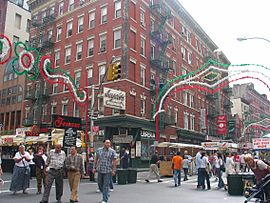
One of the most special and popular Italian American traditions is their feasts. You can find these festive celebrations all over the United States. Wherever there is an "Italian neighborhood," often called "Little Italy," these feasts take place. Famous examples include the Feast of San Gennaro in New York City. Another unique one is the Our Lady of Mount Carmel "Giglio" Feast in Brooklyn, New York. Italian feasts show great devotion to Jesus Christ and special patron saints.
On the last Sunday in August, people in Boston's North End celebrate the "Feast of all Feasts." This honors St. Anthony of Padua. It started over 300 years ago in Montefalcione, Italy. Perhaps the most widely known is St. Joseph's feast day on March 19.
These feasts are more than just single events. "Feast" (Festa in Italian) means all the different activities around a religious holiday. These can be secular or religious, indoors or outdoors. Italian feasts usually include festive meals shared by the community. They also have religious services, games, and large outdoor parades. These parades feature statues decorated with jewels and donations. The celebration often lasts several days. A church community or religious group prepares for it for many months.
Currently, over 300 Italian feasts are celebrated across the United States. A notable one is Festa Italiana, held every summer in Milwaukee. Millions of Americans from different backgrounds visit these feasts each year. They come to enjoy Italian music and delicious food. In the past, and still today, music and food are very important parts of Italian American culture.
Television and Media

Many American television personalities have Italian roots. Talk-show hosts include Jay Leno, Jimmy Kimmel, and Kelly Ripa. Other TV personalities include Maria Bartiromo, Adam Carolla, Neil Cavuto, Kelly Monaco, Jai Rodriguez, Annette Funicello, Victoria Gotti, Tony Danza, Giuliana DePandi, Giuliana Rancic, and Bruno Cipriani.
Museums and Culture Centers
There are several museums in the United States that focus on Italian American culture:
- San Francisco, California: Museo ItaloAmericano
- Los Angeles, California: Italian American Museum of Los Angeles
- Chicago, Illinois: Casa Italia Chicago
- New Orleans, Louisiana: American Italian Cultural Center
- Albany, New York: American Italian Heritage Association and Museum
- New York, New York: Italian American Museum
- New York, Staten Island: Garibaldi-Meucci Museum
- Philadelphia, Pennsylvania: History of Italian Immigration Museum (Filitalia Foundation)
Discrimination and Stereotypes
When many Italians first immigrated to the United States, they faced widespread unfair treatment. This included problems finding homes and jobs. They were often victims of prejudice and economic exploitation. Sometimes, they even faced violence, especially in the South. Starting in the late 1880s, anti-immigrant feelings grew. Catholic churches were often damaged or burned. Italians were attacked by angry groups of people. In the 1890s, it is thought that more than 20 Italians were killed by mobs. Much of this hostility was aimed at Southern Italians and Sicilians. These groups began immigrating to the U.S. in large numbers after 1880. Before that, there were few Italians in North America.
From the very beginning of the movie industry, Italians have sometimes been shown in a negative way. They were often portrayed as violent or bad people. This unfair portrayal has continued even today. The idea of a "typical" Italian American has been created by movies and TV shows. Examples include popular films like The Godfather, Goodfellas, and Casino. TV shows like The Sopranos also contributed. This shows how mass media can create widely known, but often untrue, stereotypes.
A study from 1996 to 2001 looked at how Italian American culture was shown in films. It found that over two-thirds of the more than 2,000 films studied showed Italian Americans negatively. Also, nearly 300 movies showing Italian Americans as criminals have been made since The Godfather. This is about nine movies per year.
However, real facts show a different picture. According to recent FBI numbers, only about 3,000 people are involved in Italian American organized crime. The Italian American population is estimated to be about 18 million. This means that only about one in 6,000 Italian Americans has any connection to organized crime. This is a very small percentage (0.007%).
Demographics and Population
In the 2000 U.S. census, Italian Americans were the fifth largest ancestry group in America. About 15.6 million people, or 5.6% of the total U.S. population, reported Italian ancestry. Sicilian Americans are the largest group among Americans with specific Italian regional roots. About 83% of Italian Americans have ancestors from Sicily. By 2006, the U.S. census estimated the Italian American population at 17.8 million people. This was about 6% of the population, a 14% increase in six years.
In 2010, the American Community Survey counted almost 17.6 million Americans reporting Italian ancestry. This was 5.8% of the U.S. population. In 2015, it was 17.3 million, or 5.5%. A decade later, in 2020, the U.S. Census Bureau recorded slightly more than 16.5 million Americans with full or partial Italian ancestry. This was about 5.1% of the U.S. population.
People report their own ancestry. The decrease in Italian identification in the 21st century might mean that Italian Americans are becoming more "Americanized." They are blending into the larger group of White Americans. Younger generations are increasingly mixed with other European Americans. The number of Americans who said they were only of Italian ancestry fell. It went from 7,183,882 in 2010 to 5,724,762 in 2020. However, the number of Americans who reported Italian ancestry mixed with another ancestry grew. It increased from 10,387,926 in 2010 to 10,824,260 in 2020.
U.S. States with Many Italian Americans
These U.S. states have over 10% of their population with Italian ancestry:
- Rhode Island 18.9%
- Connecticut 18.7%
- New Jersey 16.8%
- New York 15.93%
- Massachusetts 13.9%
- Pennsylvania 12.2%
- New Hampshire 10.7%
- Delaware 10.1%
U.S. Communities with Many Italian Americans
The top 20 U.S. communities with the highest percentage of people reporting Italian ancestry are:
- Fairfield, New Jersey 50.3%
- Johnston, Rhode Island 49.5%
- North Branford, Connecticut 43.9%
- East Haven, Connecticut 43.6%
- Hammonton, New Jersey 43.2%
- Ocean Gate, New Jersey 42.6%
- East Hanover, New Jersey 41.3%
- North Haven, Connecticut 41.2%
- Cedar Grove, New Jersey 40.8%
- Wood-Ridge, New Jersey 40.6%
- North Providence, Rhode Island 38.9%
- Dunmore, Pennsylvania 38.9%
- Newfield, New Jersey 38.8%
- Saugus, Massachusetts 38.5%
- Jenkins, Pennsylvania 38.4%
- West Pittston, Pennsylvania 37.9%
- Old Forge, Pennsylvania 37.8%
- Lowellville, Ohio 37.5%
- Hughestown, Pennsylvania 37.5%
- Prospect, Connecticut 37.5%
See also
 In Spanish: Inmigración italiana en Estados Unidos para niños
In Spanish: Inmigración italiana en Estados Unidos para niños




